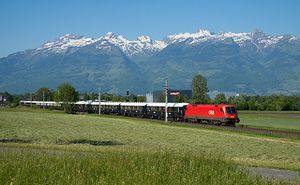Trans-Benacian Railway

The Orient Express is a luxurious long-distance train service founded in 1672 AN by the Company de Orient Express.
The regular service is a direct connection between 's Koningenwaarde and Shirekeep.
History
The dream for a long-distance train came when Frederic Blijmackers traveled as a journalist on the royal train from ‘s Koningenwaarde to Brandenburg. Bent over a map of the entire continent of Benacia, Bijmackers drew different routes for long-distance trains. The focus shifted to the direct connection between 's Koningenwaarde and Shirekeep.
Since 13 XI.1674 AN, all train services to and from Severnaya Gubernya have been canceled. The result is that there is no train service to Shirekeep. Only the train service to Eliria is operational.
Route

Express experience
A description of the journey with the Orient Express, from the starting point in 's Koningenwaarde to Shirekeep.
's Koningenwaarde

The Hoofdstation Noord in 's Koningenwaarde is the starting point for the Orient Express. The shielded platform is specially equipped to receive the often richer travelers, such as taxis and private drivers can drop their passengers directly on the platform and a red carpet to the entrances to the train. Travelers are personally welcomed by the staff, including the chief conductor and the chef. A ticket does not contain a number, but is in the name of the traveler.
The Orient Express is not a train service, like a commuter train. But is a train service in which travel, leisure and experience come together. Hence the term: "Orient Experience". In the days before the departure of the train, travelers arrive in 's Koningenwaarde. Often travelers stay in one of the hotels in the city. Some hotels are specially rented by the Company the Orient Express for travelers. But both in 's Koningenwaarde and in other cities, the Company has its own Orient Express hotels, often with the name: Oriental Hotel.
The train consists of at least 15 carriages, such as a saloon carriage, dinner carriage, luggage carriages and sleeping carriages. During the trip to Shirekeep, the locomotives will be changed every time the train crosses a national border.
When the train departs from 's Koningenwaarde, all passengers are invited in the salon carriage for coffee and chocolates. The train passes the buildings of 's Koningenwaarde faster and faster, while the other traffic moves slowly under and above the train tracks. The centre of the city is surrounded by a green belt and the A14 highway. This is followed by the northern suburb and the Paleys Raiselle can be seen for a short moment. Subsequently, meadows can be seen on the left and on the right there is a view of the river Zwette.
This canalized river connects the Rhijne with the Linge, which for centuries has provided a thriving economy in the region with in particular the city 's Koningenwaarde. The meadows are interrupted by parts of the Waarder Woud. Today, the Waarder Woud is only a fraction of its original size, but in the spring the forest turns purple and that compels writers to tales. Tales from the Waarder Woud
Soon afterwards the meadows start again and one of the side branches of the Zwette is crossed. The places Berg and Kolmar come into view, respectively left and right of the railway line and river. The places are connected by a bridge over the railway and river, while the wheels rattle over the railroad switches. Both places have a common train station, with a main rail available for continuous trains, such as the Orient Express. The train whips past the station, after which the passengers get a view of the Abbey of Kolmar. This is located on the hills north of the place of the same name. The abbey remains visible for some time, as the railway line and the river circle around the hill of the abbey. While the adjacent road bends towards Justusbergh.